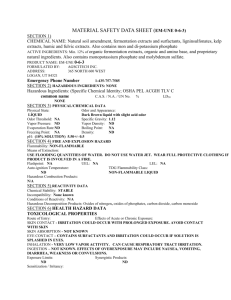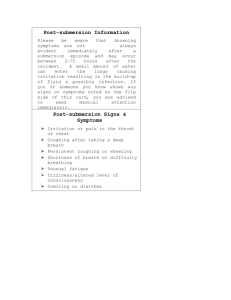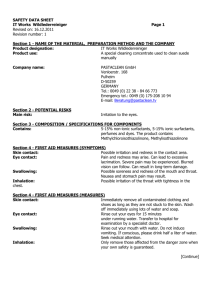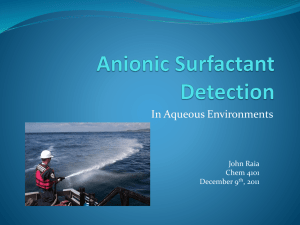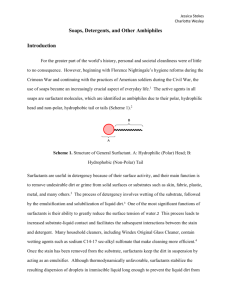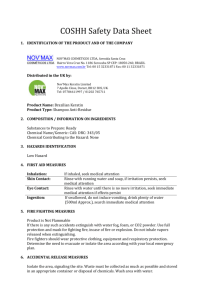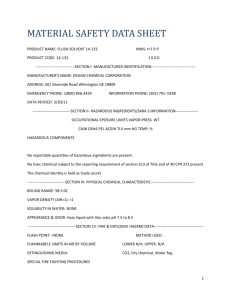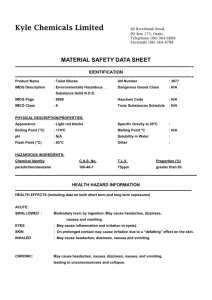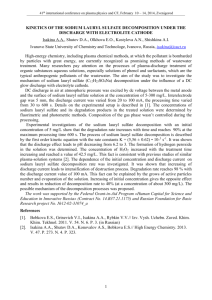Ingredients To Avoid
advertisement
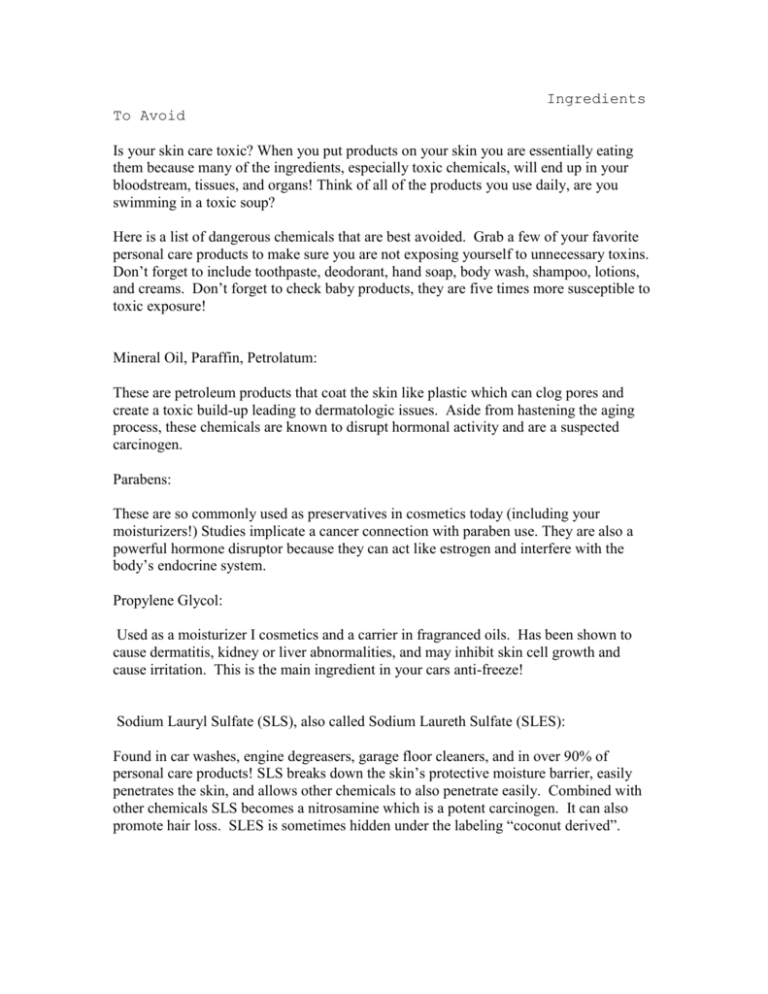
Ingredients To Avoid Is your skin care toxic? When you put products on your skin you are essentially eating them because many of the ingredients, especially toxic chemicals, will end up in your bloodstream, tissues, and organs! Think of all of the products you use daily, are you swimming in a toxic soup? Here is a list of dangerous chemicals that are best avoided. Grab a few of your favorite personal care products to make sure you are not exposing yourself to unnecessary toxins. Don’t forget to include toothpaste, deodorant, hand soap, body wash, shampoo, lotions, and creams. Don’t forget to check baby products, they are five times more susceptible to toxic exposure! Mineral Oil, Paraffin, Petrolatum: These are petroleum products that coat the skin like plastic which can clog pores and create a toxic build-up leading to dermatologic issues. Aside from hastening the aging process, these chemicals are known to disrupt hormonal activity and are a suspected carcinogen. Parabens: These are so commonly used as preservatives in cosmetics today (including your moisturizers!) Studies implicate a cancer connection with paraben use. They are also a powerful hormone disruptor because they can act like estrogen and interfere with the body’s endocrine system. Propylene Glycol: Used as a moisturizer I cosmetics and a carrier in fragranced oils. Has been shown to cause dermatitis, kidney or liver abnormalities, and may inhibit skin cell growth and cause irritation. This is the main ingredient in your cars anti-freeze! Sodium Lauryl Sulfate (SLS), also called Sodium Laureth Sulfate (SLES): Found in car washes, engine degreasers, garage floor cleaners, and in over 90% of personal care products! SLS breaks down the skin’s protective moisture barrier, easily penetrates the skin, and allows other chemicals to also penetrate easily. Combined with other chemicals SLS becomes a nitrosamine which is a potent carcinogen. It can also promote hair loss. SLES is sometimes hidden under the labeling “coconut derived”. Toluene: Danger!! Poison! Harmful or fatal if swallowed! Harmful if inhaled or absorbed by the skin! Made from petroleum or coal tar and found in most synthetic fragrances and nail polish. Chronic exposure has been linked to anemia, lowered blood cell count, liver or kidney damage, and may affect a developing fetus. Other names toluene may be hidden under include Butylatd Hydroxytoluene (BHT), benzoic, and benzyl. Dioxane: Found in compounds known as PEG, Polysorbates, Laureth, and ethoxylated alcohols. These are commonly used in personal care products and are usually contaminated with high concentrations of volatile 1,4-dioxane which is easily absorbed through the skin. Dioxane’s carcinogenicity was first reported in 1965 and later confirmed in studies including one from the National Cancer Institute in 1978. Nasal passages and the liver are the most vulnerable. Dioxane is a synthetic derivative of coconut, so watch for labels that say “comes from coconut”> Hydroquinone: Commonly prescribed for lightening pigmentation spots on the skin. This is a known carcinogen that easily penetrates the skin and migrates to the spleen and liver wreaking havoc. It has been banned in most countries now and the FDA is finally getting on the ball here in the US! Please consider a safer alternative for pigmentation, like 302’s new skin lightener, made from a special high potency vitamin C. Benzyl Peroxide: Commonly used to spot treat acne lesions. Using this ingredient is the fastest way to cause pre-mature aging of the skin, irritation, and inflammation! It promotes oxidation and the formation of free radicals on the skin and really isn’t the most effective, and certainly not the safest solution for unsightly pimples. Try brewing some green tea and making a warm compress. The plant actives are highly effective for healing, soothing, and calming acne without unpleasant side affects. Also try spot treating with pure tea tree oil. Phenyl Carbolic Acid: Found in many lotions and creams. Can cause circulatory collapse, paralysis, convulsions, coma, and even death from respiratory failure. Acrylamide: Found in many hand and face creams. Linked to mammary tumors in lab research. Also formed in carbohydrate foods like potatoes when fried at high temperatures with oil. Think twice the next time fries or potato chips sound appealing! This has been proven to be carcinogenic. These are the most ubiquitous toxic ingredients to avoid in your personal care products. The following is a more complete list of chemicals to avoid applying to your skin. Remember, what goes on your body eventually ends up inside of your body, so only choose the most pure ingredients that you can pronounce potentially eat! Toxic Ingredient Directory 1. 4-dioxane: A carcinogenic contaminant of cosmetic products. Almost 50% of cosmetics containing ethoxylated surfactants were found to contain dioxane. See Ethoxylated surfactants From Material Safety Data Sheet (MSDS): 1,4-DIOXANE MAY EXERT ITS EFFECTS THROUGH INHALATION, SKIN ABSORPTION, AND INGESTION. 1,4-DIOXANE IS LISTED AS A CARCINOGEN. EFFECTS OF OVEREXPOSURE: 1,4-DIOXANE IS AN EYE AND MUCOUS MEMBRANE IRRITANT, PRIMARY SKIN IRRITANT, CENTRAL NERVOUS SYSTEM DEPRESSANT, NEPHROTOXIN, AND HEPATOTOXIN. ACUTE EXPOSURE CAUSES IRRITATION, HEADACHE, DIZZINESS, AND NARCOSIS. CHRONIC INHALATION EXPOSURE CAN PRODUCE DAMAGE TO THE LIVER AND KIDNEYS, AND BLOOD DISORDERS. MEDICAL CONDITION AGGRAVATED BY EXPOSURE PRECLUDE FROM EXPOSURE THOSE INDIVIDUALS WITH DISEASE OF THE BLOOD, LIVER KIDNEYS, CENTRAL NERVOUS SYSTEM, AND THOSE SUSCEPTIBLE TO DERMATITIS. 2. bromo-2-nitropropane-1,3-diol (Bronopol): Toxic, causes allergic contact dermatitis. See Nitrosating agents 3. Alcohol, Isopropyl (SD-40): A very drying and irritating solvent and dehydrator that strips your skin's natural acid mantle, making us more vulnerable to bacteria, moulds and viruses. It is made from propylene, a petroleum derivative. It may promote brown spots and premature aging of skin 4. Ammonium Laureth Sulfate (ALES): See Anionic Surfactants See Sodium Laureth Sulfate See Nitrosating Agents 5. Ammonium Lauryl Sulfate (ALS): See Anionic Surfactants See Sodium Laureth Sulfate See Nitrosating Agents 6. Anionic Surfactants: Anionic refers to the negative charge these surfactants have. They may be contaminated with nitrosamines, which are carcinogenic. Surfactants can pose serious health threats. They are used in car washes, as garage floor cleaners and engine degreasers - and in 90% of personal-care products that foam. Sodium Lauryl Sulfate (SLS) Sodium Laureth Sulfate (SLES) Ammonium Lauryl Sulfate (ALS) Ammonium Laureth Sulfate (ALES) Sodium Methyl Cocoyl Taurate Sodium Lauroyl Sarcosinate Sodium Cocoyl Sarcosinate Potassium Coco Hydrolysed Collagen TEA (Triethanolamine) Lauryl Sulfate TEA (Triethanolamine) Laureth Sulfate Lauryl or Cocoyl Sarcosine 7. Disodium Oleamide Sulfosuccinate Disodium Laureth Sulfosuccinate Disodium Dioctyl Sulfosuccinate etc Benzalkonium Chloride: Highly toxic, primary skin irritant. See Cationic surfactants From Material Safety Data Sheet (MSDS): MATERIAL IS HIGHLY TOXIC VIA ORAL ROUTE. EFFECTS OF OVEREXPOSURE: MISTS CAN CAUSE IRRITATION TO THE SKIN, EYES, NOSE, THROAT AND MUCOUS MEMBRANES. AVOID DIRECT CONTACT. SYMPTOMS: MUSCULAR PARALYSIS, LOW BLOOD PRESSURE, CNS DEPRESSION AND WEAKNESS. EMERGENCY AND FIRST AID PROCEDURES EYES: CORROSIVE! IMMEDIATELY WASH EYES WITH PLENTY OF WATER. INHALATION: REMOVE PERSON TO FRESH AIR. GIVE OXYGEN (IF BREATHING IS DIFFICULT). CALL PHYSICIAN. INGESTION: IF CONSCIOUS, IMMEDIATELY DRINK LARGE QUANTITIES OF FLUID TO DILUTE AND INDUCE VOMITING. CALL PHYSICIAN. 8. Butylated Hudroxyanisole (BHA): Causes allergic contact dermatitis. 9. Butylated Hydroxytoluene (BHT): Causes allergic contact dermatitis. Contains toluene. See Toluene 10. Cationic surfactants: These chemicals have a positive electrical charge. They contain a quaternary ammonium group and are often called "quats". These are used in hair conditioners, but originated from the paper and fabric industries as softeners and anti-static agents. In the long run they cause the hair to become dry and brittle. They are synthetic, irritating, allergenic and toxic, and oral intake of them can be lethal. Stearalkonium chloride Benzalkonium chloride Cetrimonium chloride Cetalkonium chloride Lauryl dimonium hydrolysed collagen 11. Cetalkonium chloride: See Cationic surfactants 12. Cetrimonium chloride: See Cationic surfactants 13. Chloromethylisothiazolinone: Causes contact dermatitis 14. Isothiazolinone: Causes contact dermatitis From Material Safety Data Sheet (MSDS): EYE CONTACT: CORROSIVE TO THE EYES WITH POSSIBLE PERMANENT DAMAGE. SKIN CONTACT: CORROSIVE TO THE SKIN, POSSIBLY RESULTING IN THIRD DEGREE BURNS. CAN BE HARMFUL IF ABSORBED. CAN CAUSE ALLERGIC CONTACT DERMATITIS IN SUSCEPTIBLE INDIVIDUALS. INGESTION: CAN BE FATAL. INHALATION: CAN BE CORROSIVE TO THE MUCOUS MEMBRANES AND THE LUNGS. CAN CAUSE AN ALLERGIC REACTION IN SUSCEPTIBLE INDIVIDUALS. 15. Cocoamidopropyl Betaine: From Material Safety Data Sheet (MSDS): CAN CAUSE EYE AND SKIN IRRITATION. 16. Cocoyl Sarcosine: See Nitrosating agents 17. Cyclomethicone: See Silicone derived emollients 18. DEA (diethanolamine), MEA (Monoethanolamine), & TEA (triethanolamine): Often used in cosmetics to adjust the pH, and used with many fatty acids to convert acid to salt (stearate), which then becomes the base for a cleanser. TEA causes allergic reactions including eye problems, dryness of hair and skin, and could be toxic if absorbed into the body over a long period of time. These chemicals are already restricted in Europe due to known carcinogenic effects. Dr. Samuel Epstein (Professor of Environmental Health at the University of Illinois) says that repeated skin applications . . . of DEA-based detergents resulted in a major increase in the incidence of liver and kidney cancer. See Nitrosating agents From Material Safety Data Sheet (MSDS): Health Hazard Acute And Chronic: Product is severely irritating to body tissues and possibly corrosive to the eyes. Explanation Carcinogenicity: Amines react with nitrosating agents to form nitrosamines, which are carcinogenic. 19. Diazolidinyl urea: Established as a primary cause of contact dermatitis (American Academy of Dermatology). Contains formaldehyde, a carcinogenic chemical, is toxic by inhalation, a strong irritant, and causes contact dermatitis. See Formaldehyde From Material Safety Data Sheet (MSDS): CAUSES SEVERE EYE IRRITATION. MAY CAUSE SKIN IRRITATION. SIGNS AND SYMPTOMS OF EXPOSURE SYMPTOMS OF INHALATION: IF MISTED, WILL CAUSE IRRITATION OF MUCOUS MEMBRANES, NOSE, EYES AND THROAT. COUGHING, DIFFICULTY IN BREATHING. SYMPTOMS OF SKIN CONTACT: CONTACT CAUSES SMARTING AND BURNING SENSATIONS, INFLAMMATION, BURNS, PAINFUL BLISTERS. PROFOUND DAMAGE TO TISSUE. SYMPTOMS OF EYE CONTACT: WILL CAUSE PAINFUL BURNING OR STINGING OF EYES AND LIDS, WATERING OF EYES, AND INFLAMMATION OF CONJUNCTIVA. 20. Dimethicone: See Silicone derived emollients 21. Dimethicone Copolyol: See Silicone derived emollients 22. Disodium Dioctyl Sulfosuccinate: See Anionic surfactants 23. Disodium Laureth Sulfosuccinate: See Anionic surfactants See Ethoxylated surfactants 24. Disodium Oleamide Sulfosuccinate: See Anionic Surfactants 25. DMDM Hydantoin: Contains formaldehyde. See Formaldehyde 26. Ethoxylated surfactants: Ethoxylated surfactants are widely used in cosmetics as foaming agents, emulsifiers and humectants. As part of the manufacturing process the toxic chemical 1,4-dioxane, a potent carcinogen, is generated. On the label, they are identified by the prefix "PEG", "polyethylene", "polyethylene glycol", "polyoxyethylene", "-eth-", or "-oxynol-". See 1. 4-Dioxane 27. FD&C Colour Pigments: Synthetic colours made from coal tar. Contain heavy metal salts that deposit toxins onto the skin, causing skin sensitivity and irritation. Animal studies have shown almost all of them to be carcinogenic. 28. Formaldehyde: Formaldehyde is a known carcinogen (causes cancer). Causes allergic, irritant and contact dermatitis, headaches and chronic fatigue. The vapour is extremely irritating to the eyes, nose and throat (mucous membranes). See Nitrosating agents 29. Fragrance: Fragrance on a label can indicate the presence of up to four thousand separate ingredients, many toxic or carcinogenic. Symptoms reported to the USA FDA include headaches, dizziness, allergic rashes, skin discoloration, violent coughing and vomiting, and skin irritation. Clinical observation proves fragrances can affect the central nervous system, causing depression, hyperactivity, and irritability. 30. Hydrolysed Animal Protein: See Nitrosating agents 31. Imidazolidinyl urea: The trade name for this chemical is Germall 115. Releases formaldehyde, a carcinogenic chemical, into cosmetics at over 10°C. Toxic. See Formaldehyde See Nitrosating agents 32. Lanolin: Any chemicals used on sheep will contaminate the lanolin obtained from the wool. The majority of lanolin used in cosmetics is highly contaminated with chlorinated organo pesticides like DDT. 33. Lauryl dimonium hydrolysed collagen: See Cationic surfactants 34. Lauryl or Cocoyl Sarcosine: See Anionic Surfactants 35. Lauryl Sarcosine: See Nitrosating agents 36. Liquidum Paraffinum: Liquidum Paraffinum is an exotic sounding way to say mineral oil (!!) See Mineral Oil 37. MEA compounds: See Nitrosating agents 38. Methylisothiazolinone and Methylchloroisothiazolinone: Both cause cosmetic allergies 39. Mineral Oil: Petroleum by-product that coats the skin like plastic, clogging the pores. Interferes with skin's ability to eliminate toxins, promoting acne and other disorders. Slows down skin function and cell development, resulting in premature aging. Used in many products (baby oil is 100% mineral oil!) Any mineral oil derivative can be contaminated with cancer causing PAH's (Polycyclic Aromatic Hydrocarbons). Manufacturers use petrolatum because it is unbelievably cheap. Mineral oil Liquidum paraffinum (also known as posh mineral oil!) Paraffin oil Paraffin wax Petrolatum 40. Nitrosating Agents: The following chemicals can cause nitrosamine contamination, which have been determined to form cancer in laboratory animals. There are wide and repeated concerns in the USA and Europe about the contamination of cosmetics products with nitrosamines. 2-bromo-2-nitropropane-1,3-diol Cocoyl Sarcosine DEA compounds Imidazolidinyl Urea Formaldehyde Hydrolysed Animal Protein Lauryl Sarcosine MEA compounds Quaternium-7, 15, 31, 60, etc Sodium Lauryl Sulfate Ammonium Lauryl Sulfate Sodium Laureth Sulfate Ammonium Laureth Sulfate Sodium Methyl Cocoyl Taurate TEA compounds 41. Paraben preservatives (methyl, propyl, butyl, and ethyl): Used as inhibitors of microbial growth and to extend shelf life of products. Widely used even though they are known to be toxic. Have caused many allergic reactions and skin rashes. Highly toxic. From Material Safety Data Sheet (MSDS): EMERGENCY OVERVIEW: WARNING! HARMFUL IF SWALLOWED OR INHALED. CAUSES IRRITATION TO SKIN, EYES AND RESPIRATORY TRACT. MAY CAUSE ALLERGIC SKIN REACTION. SKIN CONTACT: CAUSES IRRITATION TO SKIN. SYMPTOMS INCLUDE REDNESS, ITCHING, AND PAIN. MAY CAUSE ALLERGIC SKIN REACTIONS. EYE CONTACT: CAUSES IRRITATION, REDNESS, AND PAIN. 42. Paraffin wax/oil: Paraffin Wax is mineral oil wax. See Mineral Oil 43. Polyethylene Glycol (PEG) compounds: Potentially carcinogenic petroleum ingredient that can alter and reduce the skin's natural moisture factor. This could increase the appearance of aging and leave you more vulnerable to bacteria. Used in cleansers to dissolve oil and grease. It adjusts the melting point and thickens products. Also used in caustic spray-on oven cleaners. See Ethoxylated surfactants 44. Potassium Coco Hydrolysed Collagen: See Anionic Surfactants 45. Propylene/Butylene Glycol: Propylene glycol (PG) is a petroleum derivative. It penetrates the skin and can weaken protein and cellular structure. Commonly used to make extracts from herbs. PG is strong enough to remove barnacles from boats! The EPA considers PG so toxic that it requires workers to wear protective gloves, clothing and goggles and to dispose of any PG solutions by burying them in the ground. Because PG penetrates the skin so quickly, the EPA warns against skin contact to prevent consequences such as brain, liver, and kidney abnormalities. But there isn't even a warning label on products such as stick deodorants, where the concentration is greater than in most industrial applications. From Material Safety Data Sheet (MSDS): Health Hazard Acute And Chronic INHALATION: May cause respiratory and throat Irritation, central nervous system depression, blood and kidney disorders. May cause Nystagmus, Lymphocytosis. SKIN: Irritation and dermatitis, absorption. EYES: Irritation and conjunctivitis. INGESTION: Pulmonary oedema, brain damage, hypoglycaemia, intravascular hemolysis. Death may occur. 46. PVP/VA Copolymer: A petroleum-derived chemical used in hairsprays, wavesets and other cosmetics. It can be considered toxic, since particles may contribute to foreign bodies in the lungs of sensitive persons. 47. Quaternium-7, 15, 31, 60, etc: Toxic, causes skin rashes and allergic reactions. See Nitrosating agents From Material Safety Data Sheet (MSDS): SKIN: PROLONGED OR REPEATED EXPOSURE MAY CAUSE SKIN IRRITATION. MAY CAUSE MORE SEVERE RESPONSE IF SKIN IS DAMP. MAY BE A WEAK SKIN SENSITIZER IN SUSCEPTIBLE INDIVIDUALS AT GREATER THAN 1% IN AQUEOUS SOLUTION. 48. Rancid Natural Emollients: Natural oils used in cosmetics should be cold pressed. The refined vegetable oils found on supermarket shelves and many health food stores which lack colour, odour and taste are devoid of nutrients, essential fatty acids, vitamins and unsaponifiables - all valuable skin conditioning agents! They also contain poisonous "trans" fatty acids as a result of the refining process. Another important factor to consider with creams made from plant oil is the use-by date. The most beneficial plant oils (like rosehip, borage and evening primrose oils) are polyunsaturated, which means they oxidise and go rancid fairly quickly (about 6 months). Most off-the-shelf cosmetics have a shelf life of three years. Rancid oils are harmful, they form free-radicals, which damage and age your skin. 49. Silicone derived emollients: Silicone emollients are occlusive - that is they coat the skin, trapping anything beneath it, and do not allow the skin to breathe (much like plastic wrap would do.) Recent studies have indicated that prolonged exposure of the skin to sweat, by occlusion, causes skin irritation. Some synthetic emollients are known tumour promoters and accumulate in the liver and lymph nodes. They are also nonbiodegradable, causing negative environmental impact. Dimethicone Dimethicone Copolyol Cyclomethicone 50. Sodium Cocoyl Sarcosinate 51. Sodium Laureth Sulfate (SLES) Ammonium Laureth Sulfate (ALES) : When combined with other chemicals, SLES and ALES can create nitrosamines, a potent class of carcinogens. It is frequently disguised in semi-natural cosmetics with the explanation "comes from coconut". See Anionic Surfactants See Ethoxylated surfactants See Nitrosating agents From Material Safety Data Sheet (MSDS): WARNING! CAUSES SKIN AND EYE IRRITATION! AVOID CONTACT WITH EYES, SKIN AND CLOTHING. THE MATERIAL WAS CLASSIFIED AS A MODERATE TO SEVERE EYE IRRITANT. 52. Sodium Lauroyl Sarcosinate: See Anionic Surfactants 53. Sodium Lauryl Sulfate (SLS) Ammonium Lauryl Sulfate (ALS): Used in car washes, garage floor cleaners and engine degreasers - and in 90% of products that foam. Animals exposed to SLS and ALS experience eye damage, central nervous system depression, laboured breathing, diarrhoea, severe skin irritation, and even death. Young eyes may not develop properly if exposed to SLS and ALS because proteins are dissolved. SLS and ALS may also damage the skin's immune system by causing layers to separate and inflame. It is frequently disguised in semi-natural cosmetics with the explanation "comes from coconut". See Nitrosating agents See Anionic Surfactants From Material Safety Data Sheet (MSDS): EYE CONTACT: INSTILLATION OF A 29% SODIUM LAURYL SULFATE SOLUTION INTO THE EYES OF SIX ALBINO RABBITS PRODUCED SEVERE IRRITATION. THE MATERIAL WAS CLASSIFIED AS A SEVERE SKIN IRRITANT. 54. Sodium Methyl Cocoyl Taurate: See Nitrosating agents See Anionic Surfactants 55. Stearalkonium Chloride: A chemical used in hair conditioners and creams. Causes allergic reactions. Stearalkonium chloride was developed by the fabric industry as a fabric softener, and is a lot cheaper and easier to use in hair conditioning formulas than proteins or herbals, which do help hair health. Toxic. See Cationic surfactants 56. Talc: Scientific studies have shown that routine application of talcum powder in the genital area is associated with a three-to-fourfold increase in the development of ovarian cancer. 57. TEA (Triethanolamine) Laureth Sulfate: Synthetic emulsifier. Highly acidic. Over 40% of cosmetics containing Triethanolamine (TEA), have been found to be contaminated with nitrosamines, which are potent carcinogens. From Material Safety Data Sheet Special Hazard Precautions: PRODUCT IS SEVERELY IRRITATING TO BODY TISSUES AND POSSIBLY CORROSIVE TO THE EYES. HANDLE WITH CARE. AVOID EYE & SKIN CONTACT. AVOID BREATHING VAPORS IF GENERATED. IF THERE IS DANGER OF EYE CONTACT, WEAR A FACE SHIELD. Explanation Carcinogenicity: AMINES REACT WITH NITROSATING AGENTS TO FORM NITROSOAMINES, WHICH ARE CARCINOGENIC. See Anionic Surfactants See Nitrosating agents 58. TEA compounds: See Nitrosating agents 59. Toluene: From Material Safety Data Sheet (MSDS): POISON! DANGER! HARMFUL OR FATAL IF SWALLOWED. HARMFUL IF INHALED OR ABSORBED THROUGH SKIN. VAPOR HARMFUL. FLAMMABLE LIQUID AND VAPOR. MAY AFFECT LIVER, KIDNEYS, BLOOD SYSTEM, OR CENTRAL NERVOUS SYSTEM. CAUSES IRRITATION TO SKIN, EYES AND RESPIRATORY TRACT. INHALATION: INHALATION MAY CAUSE IRRITATION OF THE UPPER RESPIRATORY TRACT. SYMPTOMS OF OVEREXPOSURE MAY INCLUDE FATIGUE, CONFUSION, HEADACHE, DIZZINESS AND DROWSINESS. PECULIAR SKIN SENSATIONS (E. G. PINS AND NEEDLES) OR NUMBNESS MAY BE PRODUCED. VERY HIGH CONCENTRATIONS MAY CAUSE UNCONSCIOUSNESS AND DEATH. INGESTION: SWALLOWING MAY CAUSE ABDOMINAL SPASMS AND OTHER SYMPTOMS THAT PARALLEL OVER-EXPOSURE FROM INHALATION. ASPIRATION OF MATERIAL INTO THE LUNGS CAN CAUSE CHEMICAL PNEUMONITIS, WHICH MAY BE FATAL. SKIN CONTACT: CAUSES IRRITATION. MAY BE ABSORBED THROUGH SKIN. EYE CONTACT: CAUSES SEVERE EYE IRRITATION WITH REDNESS AND PAIN. CHRONIC EXPOSURE: REPORTS OF CHRONIC POISONING DESCRIBE ANEMIA, DECREASED BLOOD CELL COUNT AND BONE MARROW HYPOPLASIA. LIVER AND KIDNEY DAMAGE MAY OCCUR. REPEATED OR PROLONGED CONTACT HAS A DEFATTING ACTION, CAUSING DRYING, REDNESS, AND DERMATITIS. EXPOSURE TO TOLUENE MAY AFFECT THE DEVELOPING FOETUS. If you have an ingredient that is not listed here and are unsure of its safety please visit www.cosmeticdatabase.com
